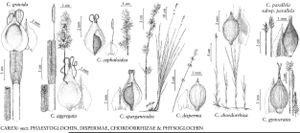Difference between revisions of "Carex chordorrhiza"
Suppl. Pl., 414. 1782.
FNA>Volume Importer |
FNA>Volume Importer |
||
| Line 34: | Line 34: | ||
-->{{#Taxon: | -->{{#Taxon: | ||
name=Carex chordorrhiza | name=Carex chordorrhiza | ||
| − | |||
|authority=Ehrhart ex Linnaeus f. | |authority=Ehrhart ex Linnaeus f. | ||
|rank=species | |rank=species | ||
| Line 49: | Line 48: | ||
|publication year=1782 | |publication year=1782 | ||
|special status= | |special status= | ||
| − | |source xml=https://jpend@bitbucket.org/aafc-mbb/fna-data-curation.git/src/ | + | |source xml=https://jpend@bitbucket.org/aafc-mbb/fna-data-curation.git/src/f50eec43f223ca0e34566be0b046453a0960e173/coarse_grained_fna_xml/V23/V23_519.xml |
|genus=Carex | |genus=Carex | ||
|section=Carex sect. Chordorrhizae | |section=Carex sect. Chordorrhizae | ||
Revision as of 20:09, 16 December 2019
Culms bluntly trigonous, 5–35 cm, smooth or scabrous distally; vegetative stems ascending to erect when young, becoming prostrate stolons at maturity, elongating to 120 cm. Leaves: sheaths with fronts pale brown at apex; ligules 0.6–6.2 mm; blades 0.4–3 mm wide. Inflorescences 5–16 × 4–12 mm; spikes ascending to spreading, ovoid to broadly ovoid, 4–8 × 2–5 mm. Pistillate scales brownish with green center and paler margins, ovate to broadly ovate. Staminate scales ovate, apex obtuse to acuminate. Perigynia dark brown, 12–28-veined, 1.4–2.2 mm wide, apex erose to weakly bidentulate, glossy. Achenes silvery brown, smooth. 2n = 60.
Phenology: Fruiting late spring–summer.
Habitat: Fens, bogs, floating mats on lakeshores, emergent sedge marshes, usually in very wet sites, often in shallow water
Elevation: 0–1500 m
Distribution

Greenland, St. Pierre and Miquelon, Alta., B.C., Man., N.B., Nfld. and Labr., N.W.T., Nunavut, Ont., P.E.I., Que., Sask., Yukon, Alaska, Ill., Ind., Iowa, Maine, Mich., Minn., Mont., N.H., N.Y., Oreg., Pa., Vt., Wis., Eurasia.
Discussion
Easily overlooked, Carex chordorrhiza is uncommon and local in much of its range, especially in districts with predominantly acidic soils. However, it can form extensive stands and be a dominant species in some boreal wetlands. Oregon collections represent occurrences in commercial cranberry bogs and are presumably introductions.
The rhizomes are short and rarely collected; the leafy vegetative stems elongate dramatically as the season progresses. At first erect to ascending, the stems eventually lie flat and next season send out roots and shoots from the nodes. These horizontal stems typically become overgrown by moss or form networks in shallow water, thus appear to be rhizomes.
Selected References
None.
